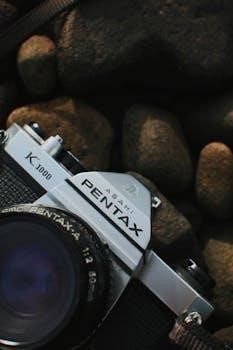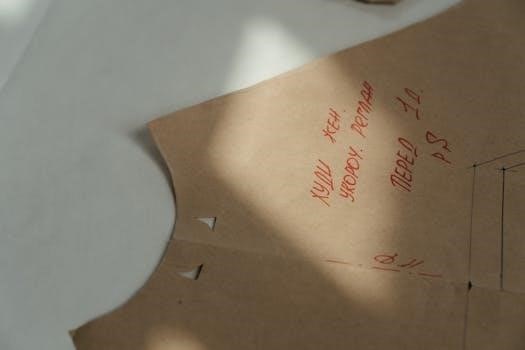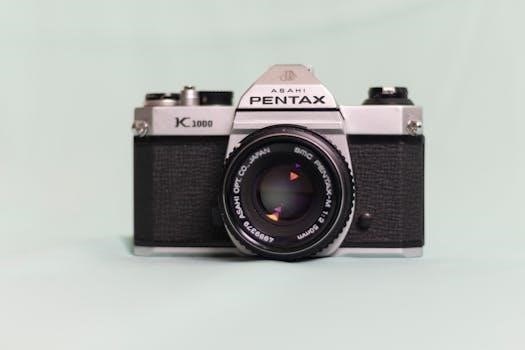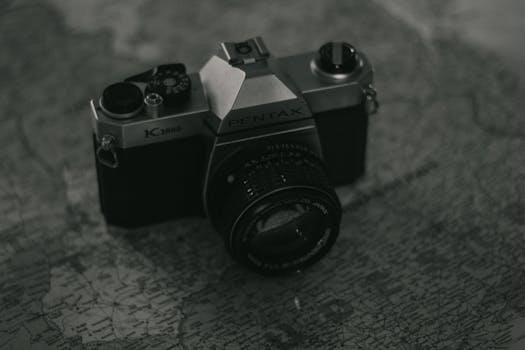The Pentax K1000 is a 35mm single-lens reflex (SLR) camera, celebrated for its simplicity and durability. It has become a favorite among beginners and photography students. Its robust, all-metal body and classic design are hallmarks, making it an ideal entry into the world of film photography.
Overview of the Pentax K1000
The Pentax K1000, a product of Asahi Optical Co., Ltd., stands as a testament to robust and straightforward camera design. This 35mm SLR gained immense popularity, especially among those new to photography, due to its user-friendly nature and dependable performance. The camera’s entirely manual operation allows photographers to grasp the fundamentals of exposure, making it an excellent educational tool. Its all-metal construction speaks to its durability, capable of withstanding the rigors of frequent use. It measures 91.4 mm in height and 143 mm in width, offering a comfortable grip. The K1000 is known for its lack of complex features, which, in turn, reduces the learning curve for beginners. Its minimal features and manual operation make it ideal for students. The camera’s basic design and the mechanical aspects are key reasons for its lasting appeal. It is important to note that the original K1000 was essentially a KM without a self-timer or depth of field preview.

Key Features of the Pentax K1000
The Pentax K1000 boasts a durable, all-metal body with a classic design. Its manual operation allows for complete control over settings. Its simplicity makes it an excellent camera for learning photography fundamentals.
Design and Build Quality
The Pentax K1000 is renowned for its robust design and exceptional build quality. Constructed with an all-metal body, the camera exudes a sense of durability and reliability, making it a dependable tool for aspiring photographers. Measuring 91.4 mm in height and 143 mm in width, its classic design is both functional and aesthetically pleasing. The camera’s construction prioritizes longevity, ensuring it can withstand the rigors of regular use. While later models incorporated some plastic components, the core build remains true to its original, sturdy design. This focus on quality materials and straightforward construction contributes to the K1000’s reputation as a workhorse camera, ideal for those learning the craft of film photography. Its timeless design makes it a classic choice for both beginners and experienced users alike.
Manual Operation and Controls
The Pentax K1000 is a fully manual camera, offering complete control over the photographic process. This manual operation is a key feature, making it an excellent learning tool for understanding the fundamentals of photography. It has a mechanical shutter with speeds ranging from 1/1000 to 1 second. The user manually sets both the aperture and shutter speed. This hands-on approach allows photographers to develop a deeper understanding of exposure settings and their impact on the final image. The simplicity of the controls is intentional, focusing on essential functions without the distractions of automatic modes. This design encourages photographers to actively engage with their camera and make conscious creative choices. The manual controls contribute to its enduring appeal among photography students and enthusiasts.
Using the Pentax K1000
Operating the Pentax K1000 involves manual film loading and unloading. Understanding shutter speeds and aperture settings is crucial for proper exposure. The camera’s design prioritizes user control, making each step a hands-on learning experience.
Loading and Unloading Film
To load film into your Pentax K1000, begin by opening the camera back, which is typically done by pulling up on the rewind knob. Place the film canister into the left chamber, then pull the film leader across the camera body to the take-up spool on the right side. Ensure the film is properly engaged with the sprockets. Advance the film with the advance lever a couple of times, ensuring the film is correctly advancing. Close the camera back. You will need to advance the film and fire the shutter several times before the frame counter shows “1” to get past the exposed film leader. Unloading film is equally straightforward. Once you’ve reached the end of your roll, rewind the film back into the canister by turning the rewind crank in the direction indicated by the arrow on the camera. Once rewound, open the back and remove the film canister. It is important to note that the film should be completely rewound into the canister before opening the back to avoid light damage.
Understanding Shutter Speeds and Aperture
The Pentax K1000, being a manual camera, requires a good understanding of shutter speeds and aperture for proper exposure. Shutter speed controls the duration the camera’s shutter remains open, measured in seconds or fractions of a second. Faster shutter speeds freeze motion, while slower speeds create motion blur. The aperture, controlled by a ring on the lens, refers to the opening of the lens diaphragm and is measured in f-stops. A larger aperture (smaller f-number, like f/2.8) lets more light in, creating a shallow depth of field, while a smaller aperture (larger f-number, like f/16) lets less light in and creates a large depth of field. Both work in tandem to control the amount of light hitting the film and are essential for creative and well-exposed photographs. Understanding their relationship is key to mastering the K1000 and manual photography.

Pentax K1000 Manual Details
The Pentax K1000 user manual is an essential guide for both beginners and experienced photographers. It provides clear instructions and practical tips for navigating the camera’s features and functions.
Availability of the User Manual
The Pentax K1000 user manual is readily accessible online, offering a valuable resource for owners of this classic camera. Numerous websites host downloadable PDF versions of the manual, often free of charge, ensuring that users can easily find the information they need. These digital copies replicate the original printed manual, providing comprehensive guidance on camera operation and maintenance. Many online platforms dedicated to camera manuals, historical documents, or photography equipment often feature the Pentax K1000 manual as part of their archives. This easy accessibility ensures that both new and long-time users can benefit from the detailed instructions, enhancing their understanding and enjoyment of the camera. The availability of these digital resources eliminates the need to search for physical copies, making learning about the K1000 more convenient.
Key Sections in the Instruction Manual
The Pentax K1000 instruction manual is logically structured, with key sections covering essential aspects of the camera’s operation. These sections include detailed explanations on loading and unloading film, a crucial step for any film photographer. The manual also provides comprehensive guidance on understanding and adjusting shutter speeds and aperture settings, which are fundamental to controlling exposure. Furthermore, it delves into the camera’s manual controls, ensuring users grasp how to operate the K1000 effectively. Other vital sections may cover topics such as lens mounting, battery information, and helpful hints for achieving optimal exposure. The manual also often includes troubleshooting tips and maintenance advice, equipping users with the necessary knowledge to care for their camera. Understanding these sections is key to mastering the Pentax K1000.

Technical Specifications and Compatibility
The Pentax K1000 features a mechanical shutter with speeds from 1/1000 to 1 second, plus Bulb mode. It has a standard K-mount lens mount. Its flash sync speed is 1/60 second. These specifications define its functionality.
Lens Compatibility
The Pentax K1000 utilizes the Pentax K-mount, a bayonet-style mount that allows for a wide array of interchangeable lenses. This mount is a significant feature, offering compatibility with numerous lenses produced by Pentax and other manufacturers. While the K1000 does not support autofocus, it seamlessly accepts a vast selection of manual focus lenses. These include the popular SMC Pentax-M series, known for their quality and compact design. However, it is important to note that the K1000 does not have any automatic features, so lenses that rely on camera automation may not function as intended. Adapters might be needed to use older screw-mount Takumar lenses, which require a stop-down metering approach. Therefore, users must verify compatibility before mounting lenses to avoid potential issues. Understanding lens compatibility is crucial for optimal performance with this versatile camera, ensuring a seamless photographic experience.
Shutter and Flash Sync Speeds
The Pentax K1000 features a mechanical shutter, offering a range of speeds from 1/1000th of a second to 1 second, in addition to a Bulb (B) setting for extended exposures. This manual operation is essential for learning the fundamentals of photography. The camera’s flash synchronization speed is 1/60th of a second, which is a standard speed for many film cameras of its era. This speed dictates the fastest shutter speed that can be used when employing flash photography, preventing the appearance of black bars in your photos. When using flash, it is crucial to set the shutter to 1/60th of a second or slower to ensure proper exposure. Understanding the shutter speeds and flash sync speed is crucial for achieving well-exposed photographs under various lighting conditions. The manual nature of the camera promotes hands-on learning for photographers.

Maintenance and Troubleshooting
Maintaining your Pentax K1000 involves basic care, such as keeping it clean and dry. Addressing common issues, like meter malfunctions, can often be done with simple troubleshooting. Regular care extends the life of this classic camera.
Basic Maintenance Tips
To ensure your Pentax K1000 remains in optimal condition, regular basic maintenance is essential. Always keep the camera body and lens clean by using a soft, dry cloth to gently wipe away dust and fingerprints. Avoid using harsh chemicals or solvents, as these can damage the camera’s finish. Store your K1000 in a dry environment, away from extreme temperatures or humidity. It is also wise to protect it from impacts, as the internal mechanisms are delicate. Regularly check the battery compartment to prevent any corrosion, replacing batteries when necessary. Furthermore, when not in use, store the camera with the lens cap on to protect the lens from scratches and dust; These simple measures will contribute to the longevity and performance of your Pentax K1000.
Common Issues and Solutions
The Pentax K1000, while robust, can encounter some common issues. One frequent problem is a malfunctioning light meter; if the meter isn’t responding, check the battery and ensure the contacts are clean. Another possible issue is the shutter not firing correctly, which may be due to mechanical wear or a buildup of debris. If the film advance lever feels stiff or jammed, do not force it, as this could cause damage; instead, inspect the film loading area. Sometimes, lenses may feel stiff when mounting or unmounting; ensure they are properly aligned. If the camera’s mirror gets stuck or seems sluggish, it may require professional attention. Consulting the user manual can provide further insight into these and other issues.
